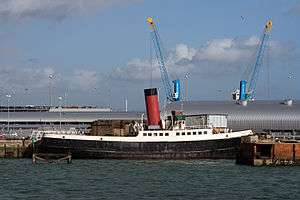TSS T/T Calshot
 | |
| History | |
|---|---|
| Name: |
|
| Owner: |
|
| Port of registry: |
|
| Builder: | John I Thorneycroft & Co. |
| Launched: | 4 November 1929 |
| In service: | 1930 |
| Out of service: | 1986 |
| Identification: | IMO Number 161681 |
| Status: | Preserved |
| General characteristics | |
| Class and type: | Tug Tender |
| Tonnage: | |
| Length: | 147 feet 0 inches (44.81 m) |
| Beam: | 33 feet 1 inch (10.08 m) |
| Installed power: | 1500 bhp |
| Propulsion: |
|
| Capacity: | 566 passengers |
TSS T/T Calshot is a tug tender built in 1929 by John I Thornycroft & Co, and completed in 1930 for the Red Funnel Line. Upon the tugboat's completion, she was put into service tendering the various liners that stopped either in the Solent or Southampton Water which saved them the time and expense of docking just to take up or set down a few passengers. She was also used to augment the excursion fleet. Calshot remained in service with Red Funnel from 1930-1964.[1]
At the outbreak of World War II, Calshot was appropriated by the Admiralty for use at Scapa Flow. In 1942 she was transferred to the River Clyde where she acted as tender to the two Cunard Line Queens, RMS Queen Elizabeth and RMS Queen Mary, transferring approximately 1,500,000 servicemen.[2] In 1944 she returned to Southampton for the build up to D-Day.
Calshot featured prominently in the 1952 British Transport Films production "Ocean Terminal", in which, amongst other things, she was filmed easing RMS Queen Elizabeth away from its berth.
In 1964, Red Funnel sold the Calshot to a subsidiary of the Holland America Line, for use as the tender for the liners Maasdam and Ryndam. For this she was based in Galway Bay, Ireland, and was renamed Galway Bay after her new area of service. She would later be operated by CIÉ as a ferry between Galway and the Aran Islands.
In 1986, Calshot was bought back by her port of registry (more specifically the Southampton City Council), with the intention of making her the centrepiece of a maritime museum in Ocean Village. In 1991, she was moved to an apparently permanent berth at the Town Quay. However, she was later moved to the Council Wharf. On April 5, 2011, Calshot was moved by tugboat from Berth 50 to Berth 42.
Calshot is one of only three surviving classical tender ships which served the great ocean liners (another famous example is the SS Nomadic, which tendered the ill-fated RMS Titanic on her maiden voyage at Cherbourg, France. The third being the Manchester Ship Canal's Daniel Adamson). In her career, Calshot has tendered some of the most famous ocean liners ever built, such as the RMS Caronia, the Cunard Queens RMS Queen Elizabeth and RMS Queen Mary, the SS United States, and the White Star Line ship RMS Olympic.
The Calshot is currently berthed in Southampton, where her restoration is being overseen by the Tug Tender Calshot Trust. The intention was to display her as part of the Aeronautica Museum in Trafalgar Dock, Southampton originally due to open in Southampton in 2015.[3] In 2012 the Associated British Ports withdrew the Trafalgar Dock location for the museum citing the need to relocate Red Funnel Ferry operations. [4]
References
- ↑ "New home for Tug Tender Calshot". National Historic Ships UK. Retrieved 5 October 2013.
- ↑ "Calshot tug boat moves to heritage site". BBC News. Retrieved 5 October 2013.
- ↑ "Boatbuilders working on Calshot". Wooden Boat Builders. Retrieved 5 October 2013.
- ↑ "Southampton Aeronautica museum site is withdrawn". BBC News. Retrieved 9 December 2013.
Sources
- Adams R B [1986] Red Funnel and Before, Kingfisher Publications, ISBN 0-946184-21-6
- Adams K [2011] Red Funnel 150, Richard Danielson, ISBN 978-0-9513155-5-2
External links
Facebook Page: https://www.facebook.com/Calshot
Trust Website: http://www.tugtendercalshot.com/